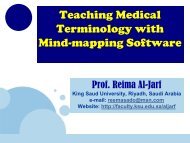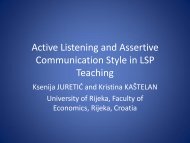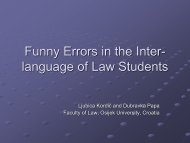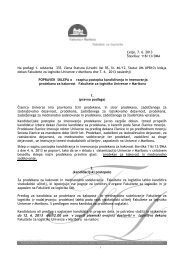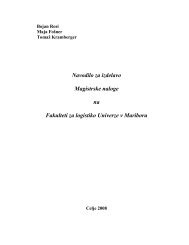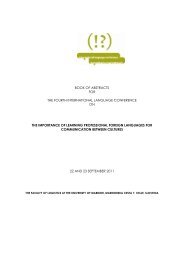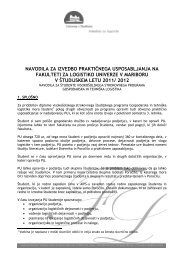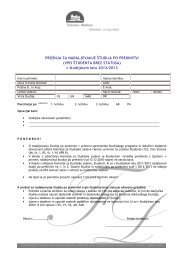Cross-Cultural Analysis of English and Italian Economic Discourse:
Cross-Cultural Analysis of English and Italian Economic Discourse:
Cross-Cultural Analysis of English and Italian Economic Discourse:
- No tags were found...
You also want an ePaper? Increase the reach of your titles
YUMPU automatically turns print PDFs into web optimized ePapers that Google loves.
<strong>Cross</strong>-<strong>Cultural</strong> <strong>Analysis</strong> <strong>of</strong><strong>English</strong> <strong>and</strong> <strong>Italian</strong> <strong>Economic</strong><strong>Discourse</strong>: ExpressingOpinion <strong>and</strong> AttitudeKsenija Juretić, Ph.D.Tamara Pirjavec Marčeta, B.A.Kristina Kaštelan, M.A.University <strong>of</strong> Rijeka, Faculty <strong>of</strong> <strong>Economic</strong>s, Rijeka, Croatia
What is common to alllanguages? Communicative function: theprimary need <strong>of</strong> human beings toexchange ideas , to express ourattitudes <strong>and</strong> share our beliefs witheach other in order to be mutuallyappreciated for WHO WE ARE, WHAT WE DO WHAT WE BELIEVE IN.A speaker (a creator <strong>of</strong> a message) Listener (an active recepient
Today’s business environment European integration, globalization national boundaries losing theirmeaning as economic frontiers:organizations are crossing their nationalborders REENGENGINEERING (Hammer&Champy, 1993): Fundamental rethinking <strong>and</strong> radicalredesign <strong>of</strong> business processes toachieve dramatic improvement incritical, contemporary measures <strong>of</strong>performance: COST , QUALITY,
Business language (LSP) The focus on performance – theprimary function Business communication- to maintainsocial <strong>and</strong> business relationship(international business transactions,meetings, conferences, socializing…) Pr<strong>of</strong>essional <strong>and</strong> scientific economicdiscourse: to inform (precise, concise,objective)
THE MAIN OBJECTIVES (1) to review the influence <strong>of</strong> theInternet on business language <strong>and</strong>culture (2) traditional categorization <strong>of</strong>language competence vs.Communicative competence (3) expressing attitudes, opinions <strong>and</strong>beliefs in <strong>English</strong> <strong>and</strong> <strong>Italian</strong>:similarities <strong>and</strong> differences
Internet, business language <strong>and</strong>culture Internet- the link is simply a mechanism toenable Hypertext to come into being.A creator: WWW <strong>of</strong> human achievements, discoveries <strong>and</strong>innovations –click on the InternetA user: Advantages: speed -navigate, surf, search ,have a better perspective than a predecessor Drawbacks: speed (wrongly formulated e-mail,use it in excess) <strong>English</strong> predominant,communication barriers…
Business LanguageThe <strong>English</strong> language we use as a worldwide acceptedmedium <strong>of</strong> communication at internationalconferences/ meetings is not culture-bound. although it is great to have <strong>English</strong> as lingua franca,our proposal is that other languages should be givenequal importance in education.To achieve this we must broaden our views <strong>and</strong> deepen ourunderst<strong>and</strong>ing <strong>of</strong> cultural <strong>and</strong> sub-cultural contexts <strong>of</strong>any language we learn or teach in order to gainthe‘authentic language performance’.
The Lewis Model classifies different cultures according tothree ‘poles’ representing different types<strong>of</strong> behaviour: Multi-active – warm, emotional,loquacious, impulsive ( SouthernEurope, Latin America <strong>and</strong> Africa); Linear-active – cool, factual, decisiveplanners (Britain, the USA, Germany,Switzerl<strong>and</strong>); Reactive – courteous, amiable,accommodating, compromiser, goodlistener (Japan, Vietnam, China, Korea,
Anglo-Saxon vs.<strong>Italian</strong>LINEAR ACTIVEMULTI-ACTIVEcool, factual, decisiveplanners, their body languageis more controlled <strong>and</strong> h<strong>and</strong>gestures very moderate whileexpressing their attitudes <strong>and</strong>opinions.essentially individualist <strong>and</strong>‘universalists’ – they thinkrules apply to every body.Focused, confrontationpossible, but ready tocompromiseemotional, loquacious <strong>and</strong>impulsive, their bodylanguage <strong>and</strong> h<strong>and</strong> gesturesto punctuate an expression<strong>and</strong> give their attitudes <strong>and</strong>opinions a shading that theword or phrase itself lacks.essentially collectivist <strong>and</strong> atthe same time ‘particularist’ -they believe that personalrelationships <strong>and</strong> friendshipsshould take precedence overrules <strong>and</strong> regulations.do many things at the sametime; they are flexible, goodat changing plans <strong>and</strong> happyto improvise.
Language knowledge vs.Communicative competenceTraditional approach: Focused on 4 skills <strong>and</strong>3 aspects <strong>of</strong>knowledge: Grammatical(vocabulary,morphology <strong>and</strong> syntax) Textual (cohesion,rethorical orconversationalorganisation) Sociolinguistic(varieties, registers<strong>and</strong> culturalreferences)Communicativecompetence:Judgments on what is: systamaticlly possible(what the grammarwill allow); Pshycho-linguisticallyfeasable ( what themind will allow); Socio-culturallyappropriate ( whatsociety will allow)
Communicative successDepends on:BACKGROUND KNOWLEDGE –past experience, current input, situational <strong>and</strong>cultural contextDISCOURSE DOMAIN- an internal interpretation as a cognitive constructcreated by a language learner/user for inter-language development <strong>and</strong> use.Sufficient contextual cues it would enable usto recognize them in the environment, identify the situation<strong>and</strong> our role in it.Insufficient- insecurity, poor communicative performanceSTRATEGIC COMPETENCE is a mediator between the internal traits <strong>of</strong> thelanguage user’s background knowledge <strong>and</strong> language knowledge <strong>and</strong>the external characteristics <strong>of</strong> the situational <strong>and</strong> cultural context, controlling theinteraction between them
• Both we, as teachers <strong>of</strong> language for specific purpose (LSP),<strong>and</strong> our students should broaden our views on cultural <strong>and</strong>sub-cultural aspects <strong>of</strong> a language in order ]to achievethe ‘authentic language performance’.• The three ‘poles’ representing different types <strong>of</strong> behaviour:Multi-active, Linear-active <strong>and</strong> Reactive, may serve as signpostson the fast track by <strong>of</strong>fering us contextual clues for teaching,learning, operating <strong>and</strong> living in this global world <strong>of</strong> ours.•to appreciate = to underst<strong>and</strong>(different cultural contexts<strong>and</strong> be aware <strong>of</strong> their similarities <strong>and</strong> differences)



